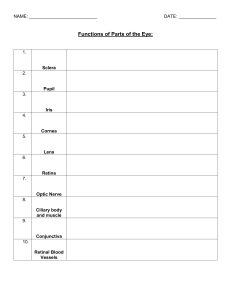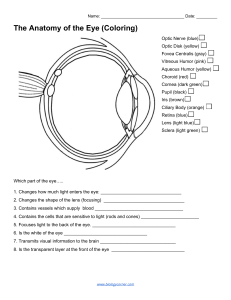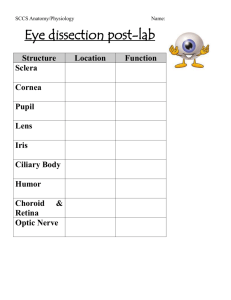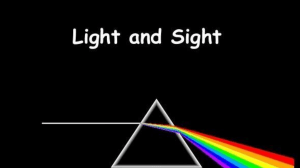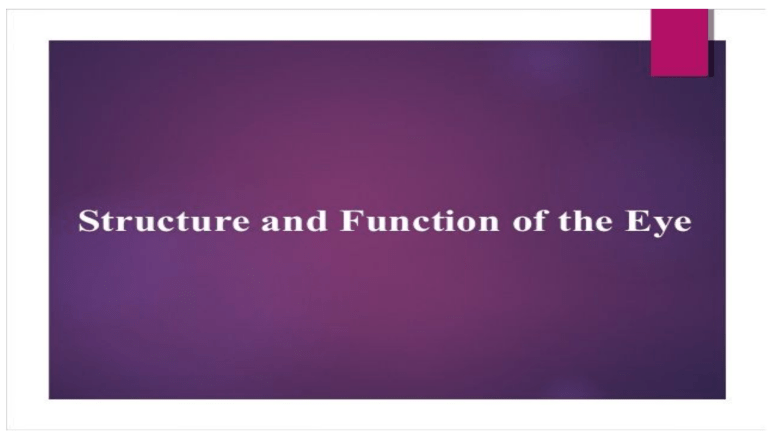
Lacrimal glands are modified form of sweat glands situated at superolateral surface of the eyelids. These glands secret clean, clear, watery fluid, tears which is saline in nature. The secretions are poured in lacrimal duct and stored in lacrimal sac. The lacrimal sac also communicates with nasal chamber through nasolacrimal duct. Function of tear - keep eyes moist and clean, kill harmful germs and nourishes the cornea and lens. Meibomian glands are oil or wax glands along the edge of the eyelids where the eyelashes are found. These glands make oil that is an important part of the eye’s tears. The oily layer is the outside of the tear film that keeps tears from drying up too quickly and protect from mechanical injury while blinking. Extraocular muscles or extrinsic muscles of the eye there are 2 types of muscles as - Rectus (straight muscle) - Oblique (oblique muscle) Rectus muscles are of 4 types ● superior rectus ● inferior rectus ● lateral rectus ● medial rectus Oblique muscles are of 2 types ● superior oblique ● inferior oblique Internal Structure of Human Eye Eye is a photosensitive organ; which reacts to light and allows vision. Eye Ball It is a spherical hollow ball like structure; so called ‘Eyeball’. The eyeball is filled with liquid and is formed by 3 Concentric layers – - External layer - Middle layer - Innermost layer Sclera External layer – it consists of sclera, cornea and conjunctiva • It is white, opaque, fibro elastic capsule that covers all of eyeball except the cornea. • It forms the shape of eyeball. • Intraocular muscles are also inserted in it and movement is controlled by cranial nerves III, IV and VI. Function: supports eyeball and provide attachment for muscles Cornea • It is clear, transparent, delicate layer that covers front part of eyeball. • It allows passage of light into eye ball. • It has a bulge Function: allows passage of light into the eye and functions as a fixed lens. Bulge helps to focus the light. Middle layer – it consists of choroid, ciliary body and iris. Choroid -The choroid is middle layer, lies closely sandwiched between retina and sclera. It is pigmented and composed of layers of blood vessels. Function: The pigmentation helps to control amount of light and nourish the back of the eye including retina. it also supports the retina properly. Cilliary body - At the junction of sclera Iris - At front region of choroid behind and cornea, choroid forms a round ciliary body. ciliary body consists specialized type of smooth muscle and gland. It has an extended structure towards the lens called suspensory ligament to hold the lens in position. Function: produces aqueous humor to bathe lens and provide nutrients to lens and cornea and provides accommodation by the action of ciliary muscles, changing the curvature of lens. cornea, it has pigmented muscular diaphragm and is separated from both sclera and retina and remain hanged as curtain, Which is visible through cornea is Iris. it gives the color of eye too. It has an opening at center called Pupil. It is also formed by 2 types of muscles outer circular and inner radial muscle. By the contraction of these muscles the size of pupil alters. Function: pupil controls the amount of light Additional Notes Additional Notes Additional Notes Innermost layer - it consists of lens, retina and optic nerves Lens • Lens is crystalline, transparent, biconvex structure enclosed by a lens capsule. • It is formed by anucleated cells. It is held in position by suspensory ligaments. The purpose of the lens is to focus light onto the back of the eye. Retina – • It is innermost photosensitive layer of the eye lies beneath the choroid. • It is a delicate membrane formed by photoreceptor cells and associated neurons. • These cells convert light rays into electrical signals. • There are are 2 types cells as rods and cones. Retina contd. ❖ These are not uniformly distributed in retina. ❖ Rods are higher in number than cones i.e. 125 million and 5 million respectively. ❖ Rods contain a pigment known as visual purple or rhodopsin that can respond to dim light or night light. ❖ Cones contain the pigment idopsin which respond to day light or bright light and are sensitive to color vision. ● There is a small depression in the retina directly opposite to lens called fovea or fovea centralis or yellow spot or macula luetea. It contains only cones no rods. ○ Function of fovea is to form sharp/clear image (inverted image). ● There is another area closer to the yellow spot from where optic nerves run behind called blind spot or optic disc which is devoid of photosensitive cells. Differences between rods and cones Rod Cell Cone Cell - Cylindrical in shape - Cone shaped - Found in large numbers (125 million) - Found in less number than rod cells (5 million) - Found in all parts of retina except - Found in all parts of retina except Blind Fovea and Blind Spot spot. Fovea contains cone cells only - It consists of pigment known as - It consists of pigment known as Rhodopsin Iodopsin - Rhodopsin is produced by retinol or - Its production is related with genetics. Vitamin A - It is functional at dim light or night, - It is functional at bright light and allow peripheral vision sensitive to colors, allow sharp vision - Its deficiency cause Night Blindness - Its deficiency causes Color Blindness. Optic nerve - the bundle of optic nerve from posterior part of retina to the brain. Function: Transmit electrical impulse from retina to the brain and facilitate to receive visual image by the individual. Chambers of eyeAgain the whole eyeball is differentiated into 2 compartments by ciliary body, lens, and suspensory ligaments . it is given as follows ● anterior aqueous humour and ● posterior vitreous humour Working of eye ● as photographic camera ● binocular vision ● stereoscopic vision Light rays coming from the object enter through the cornea, progress through aqueous humour then to the iris, pupil. The size of the pupil alters on the basis of intensity of light. There are 2 types of muscles in iris as outer circular muscle and inner radial muscle. Contraction of radial muscle causes to change into larger pupil and contraction of circular muscle causes to become smaller pupil. Then, the light falls on the lens. At the same time, curvature of lens also alters on the basis of distance of object. Far object, the lens becomes thin and near object the thicker lens. This changing of thickness is controlled by ciliary muscles connected to suspensory ligaments of lens. Finally, the light from lens passes to the retina through vitreous humour where this light is converted into a real and inverted image of object at yellow spot. This visual impulse is picked up by optic nerves. The stimulation passes to the bipolar nerve from retina and then to ganglion nerve. The optic nerves of both sides cross at optic chiasma, from where the impulses are carried by optic tract to visual area of brain, cerebrum. Here, the perfect sharp upright image is perceived by the individual as visual image.
